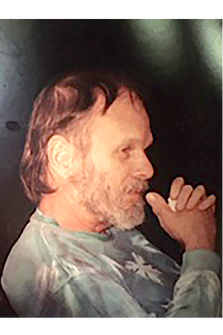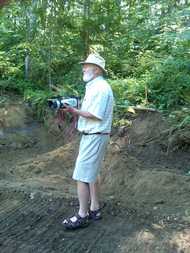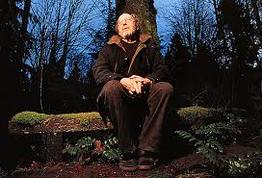Tsolum Heroes
|
Stewart “Stewie” McIntosh
FROGMAN EXTRAORDINAIRE Stewart Duncan |
Stewie is a long-standing volunteer who has contributed countless hours to improve conditions in the Tsolum River watershed for more than two decades and continues to do so. His early training and work experience as a certified professional arborist has been an asset for the Society in addition to his thoughtful, practical and inventive approaches to problem-solving. Over the years he has come up with unique systems that have aided in the efforts for a healthy river and ecology. He loves nature, really cares and it shows.
A few years ago, Stewie put his mind and expertise to the growing invasive bullfrog problem in the Tsolum watershed. The American species migrated to this area around 2000 and their populations exploded in the many year-round wetlands that feed the river and host a diverse variety of aquatic insects, amphibians and birds. The provincial department tracking their progress advised early on that bullfrogs are here to stay and we will never eradicate them. They obviously don’t know Stewie’s talents! The invasive amphibians adapted to our temperate climate and became entrenched as pond bullies. An adult bullfrog will eat anything that fits in their large mouth including native Western toads, Pacific Chorus (tree) frogs, Northern Red-legged frogs, salamanders, newts, baby water fowl and even introduced bunnies. They have become a real threat to local biodiversity. Enjoying a challenge and science and instilled with a love of nature, Stewie devoured written information on the unwanted frogs, studied existing hunting methods already undertaken by keen locals using canoes and spears and developed his own methods. He designed, constructed and experimented with a variety of traps using ordinary and inexpensive materials to develop an easier way to control them and empower others to do the same. His extensive efforts have been very successful. About four years ago, Stewie focused his energy on removing as many bullfrogs as possible from water retention ponds on local golf courses, Mulligans and Sunnydale, as well as in Finlay Creek, Sandwick retention ponds and other wetlands in the area. After just a couple years of targeted effort, the results at the end of 2021 recorded 4,300 bullfrog adults and tadpoles removed from the ecosystem. Another board member, Hamish Murray partnered with Stewie to monitor and document successes. Stewie willingly shares information and expertise with other interested locals some of whom have assisted him over the years. A little more research and field study on the tadpoles revealed that they are the only amphibian who doesn’t mature to their adult form in their birth year. The large juvenile offspring remain in the freshwater for up to four years before metamorphizing into adult frogs. This is one of the reasons they are so prolific in addition to adult females being capable of laying up to 20,000 eggs per year. Stewie modified traps and with his team targeted tadpoles almost year-round in the study ponds while adult numbers sharply declined. The results have been phenomenal – to date 7,700 adults and tadpoles have been captured by Stewie and friends! This thoughtful man also finds time to sit on the board of directors, attend and contribute to watershed protection committee meetings, plant and care for trees, lead trap building sessions, raise bullfrog awareness at outreach events and even create and carve a unique tribute to a past director, (another Stewart). All this in addition to his many other talents and interests some of which include being an expert gardener, grape grower and inventor. He is naturally inquisitive and takes the time to do his research and a great job no matter what he is working on. We truly appreciate all he does for the Tsolum watershed. Thank you Stewie for your time, talents and creativeness. |
|
For over 20 years, Stewart Duncan was a volunteer, director, president and one of the founding members of the Tsolum River Restoration Society. The capping of the mine, subsequent water quality improvements, return of pink salmon in 2015 that was of historical proportions, and a huge chum salmon return in 2016 are all the culmination of Stewart’s and other members of the community’s dedication to improving their local environment. Stewart passed away in February 2017, and is missed by everyone who knew him.
|
Father Charles Brandt
|
Our friend, fellow Tsolum director and faithful steward, Father Charles Brandt died peacefully on Sunday, October 25, 2020. He was 97. Originally from the USA, Charles was a familiar face and force around this area for over 50 years. He spent his time communing with nature, practicing his Catholic faith, fly fishing our beautiful rivers and engaging with government and his community to improve the Tsolum and Oyster River watersheds. He was a hermit-priest and spent much of his time without human company yet he slowly and quietly recruited and attracted a diverse group of people passionate about these beautiful rivers that slowly wind their way through the Comox Valley and into our hearts, kind of like Charles himself. His gentle persistence inspired and guided others to join him in his quest. He was not shy when advocating for nature and the restoration of our local rivers. This included convincing the provincial government to remediate the abandoned copper mine on Mt. Washington whose pollution decimated the Tsolum’s biotic community and his beloved steelhead run. He lived long and heartily enough to witness the positive effects of the remediation work he had been one of the catalysts of and the return of healthy populations of pink salmon, and eventually, and hopefully the elusive steelhead. I paddled the Oyster River estuary a week after Charles passed, thinking of him and gazing upriver through the slight mist of nearby rapids and the glorious sunshine. I felt his spirit in the air and water, in the river dipper who preened on a partly submerged log unfazed by my presence and in the lone fisherman casting his fly in the water a couple hundred meters upstream. Charles will be missed dearly but his legacy of a healthier environment will live on forever.
Charles was an avid birder and generously shared his photography with us. If you wish to purchase his art cards, swan prints or make a donation in his honour I am sure he would be pleased. He continues to share his love of nature with us. |
Jack Minard

Jack is the past Executive Director of TRRS, who managed the society for nearly 20 years, and played an integral part in the stewardship and restoration of the river. Besides “getting dirty” in all our projects, he raised awareness and an appreciation of The Tsolum and tributaries, and connected and built partnerships between diverse members of the community.. We are grateful for his years of work in bringing the community and so many others together to benefit the health of the Tsolum.
Dave Ferguson 1943-2022

Dave really loved the Tsolum River. So much so that for a few years he even slept near her banks, nourished by her waters and hugged by her forests. He was a nature lover, free spirit and deep thinker. He often had a twinkle in his eye and smart words on his tongue. Before his river living days, Dave served as a volunteer director of the Tsolum River Restoration Society (TRRS) from approximately 1998 to 2004. He stepped up to become president in 2000/2001 when a vacancy left a void and collective efforts to remediate the abandoned copper mine site on Mt. Washington were building momentum. In the years before that Dave was part of a wave of loud community voices raising awareness of local environmental issues, and in particular the acid rock drainage damaging the ecology of the Tsolum River and its
watershed. Large, well-attended public meetings organized by the Comox Valley Environmental Council and others were held and tough questions were asked of government representatives. The Tsolum River Task Force was birthed shortly after. A couple of years and comprehensive studies later, and after Environment Canada issued an order to make a mountain creek draining the mine site non-toxic to salmonids, the TRRS was incorporated as a non-profit society to create an entity that could accept donations, issue tax receipts, apply for funding and grants, promote collaboration and lobby for a final solution. Dave was a key player in setting up the conditions to create the successful partnership that ultimately undertook the large task.
In those early days of the TRRS, I as a newcomer to the Tsolum listened more than I spoke as Dave and the other knowledgeable Society members and directors fostered important relationships with bureaucratic and industry allies, applied for funding for endless studies, monitored water quality and pressed for action. Board discussions of technical aspects and complicated options for remediation often made my young city head spin!
Dave was an intricate part of the delicate manoeuvers that led to the successful capping of the area of the mine causing the damage. This eclectic dresser always looking for ways to promote the mission suggested we make a small handout – 4 to a sheet to save paper - with brief facts about the problem and potential solutions laid out in point form on one side and on the other contact information for government officials and industry. Informing and inviting people to make a difference. We distributed them at outreach events, meetings, bulletin boards and anywhere we could. Dave’s experience with the formation of the Green Party had taught him some PR skills!
This Tsolum soul we celebrate today was an interested, intellectual, thoughtful individual who, with like-minded people in our community, saved a river from an invisible, silent killer. Most of the 1980’s and 90’s saw very few salmon return to spawn despite government efforts to stock it. Trout populations were missing whole years, wiped out by toxic copper spikes. Now, the fish are beginning to flourish with 2021 being the largest recorded pink salmon return since 1935 at
150,000+ ! More than a decade after remediation, the river is recovering. Dave understood the science and wasn’t shy about sharing his knowledge and inspiring others. He continued to remain interested in TRRS activities after he left the Board and regularly attended annual general meetings. We all shared a love of the commons – heck, he lived in it
for a time – and felt compelled to reverse a historical travesty. We will miss Dave’s wit and wisdom and his contributions to the shared goal of fostering a healthy, diverse and productive Tsolum River.
Laura Ann O’Brien
November 2022
watershed. Large, well-attended public meetings organized by the Comox Valley Environmental Council and others were held and tough questions were asked of government representatives. The Tsolum River Task Force was birthed shortly after. A couple of years and comprehensive studies later, and after Environment Canada issued an order to make a mountain creek draining the mine site non-toxic to salmonids, the TRRS was incorporated as a non-profit society to create an entity that could accept donations, issue tax receipts, apply for funding and grants, promote collaboration and lobby for a final solution. Dave was a key player in setting up the conditions to create the successful partnership that ultimately undertook the large task.
In those early days of the TRRS, I as a newcomer to the Tsolum listened more than I spoke as Dave and the other knowledgeable Society members and directors fostered important relationships with bureaucratic and industry allies, applied for funding for endless studies, monitored water quality and pressed for action. Board discussions of technical aspects and complicated options for remediation often made my young city head spin!
Dave was an intricate part of the delicate manoeuvers that led to the successful capping of the area of the mine causing the damage. This eclectic dresser always looking for ways to promote the mission suggested we make a small handout – 4 to a sheet to save paper - with brief facts about the problem and potential solutions laid out in point form on one side and on the other contact information for government officials and industry. Informing and inviting people to make a difference. We distributed them at outreach events, meetings, bulletin boards and anywhere we could. Dave’s experience with the formation of the Green Party had taught him some PR skills!
This Tsolum soul we celebrate today was an interested, intellectual, thoughtful individual who, with like-minded people in our community, saved a river from an invisible, silent killer. Most of the 1980’s and 90’s saw very few salmon return to spawn despite government efforts to stock it. Trout populations were missing whole years, wiped out by toxic copper spikes. Now, the fish are beginning to flourish with 2021 being the largest recorded pink salmon return since 1935 at
150,000+ ! More than a decade after remediation, the river is recovering. Dave understood the science and wasn’t shy about sharing his knowledge and inspiring others. He continued to remain interested in TRRS activities after he left the Board and regularly attended annual general meetings. We all shared a love of the commons – heck, he lived in it
for a time – and felt compelled to reverse a historical travesty. We will miss Dave’s wit and wisdom and his contributions to the shared goal of fostering a healthy, diverse and productive Tsolum River.
Laura Ann O’Brien
November 2022



